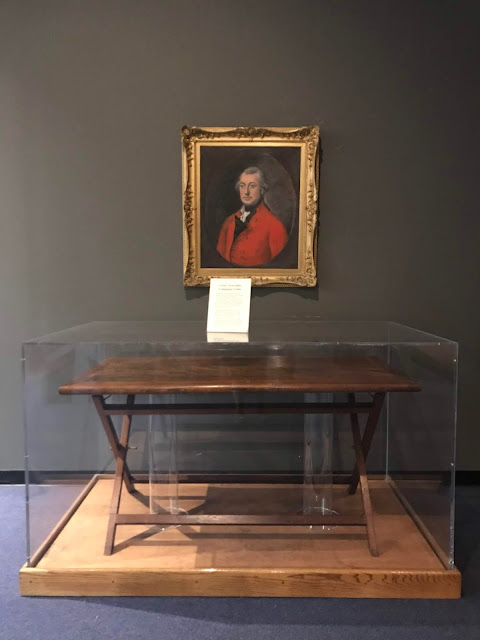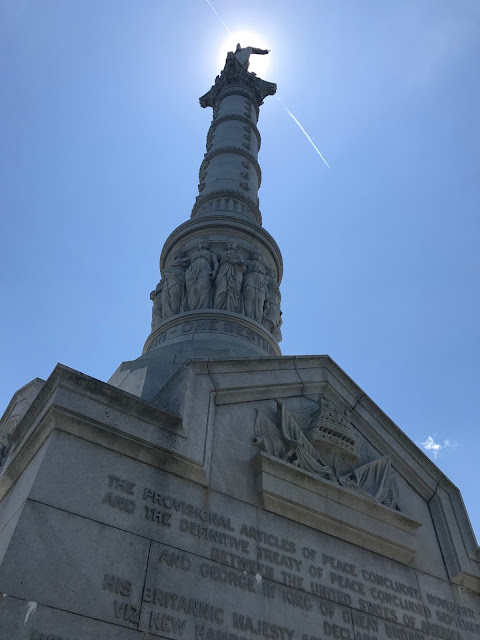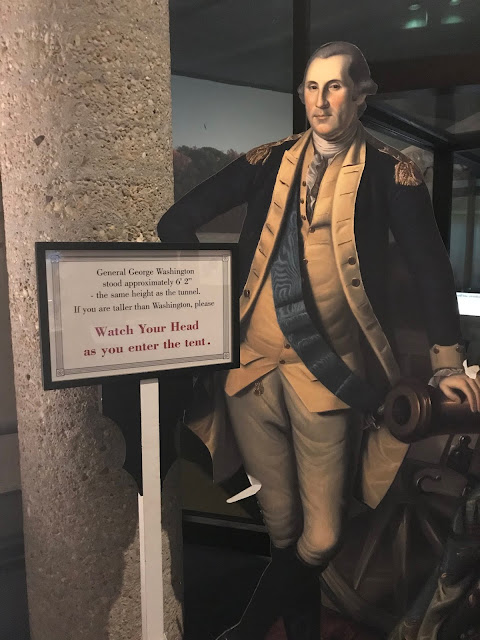On May 13, 1607, Jamestown was established as the first permanent English settlement in North America. Yorktown, about 5 miles east was the place on October 19, 1781, American and French troops defeated the British in the last major battle of the American Revolution. I suppose this is why they call the park Colonial National Historic Park and not just Yorktown or Jamestown. The park celebrates both, but we only did Yorktown.
We arrived at the Visitor Center and got oriented.
When we arrived we realized we were just in time for Hunter and Cierra to get their Junior Ranger booklets and hook onto a walking tour of Yorktown in the eyes of one of the residents of 1781 during the Revolution.
It was a fun walk and talk. The lady spoke just a colonist and dress liked one as well. She was a bit long winded but Lisa and Cierra really liked her presentation. She spoke of what taxation was like, what the war did for economy and to those living in the area. At each important location she stopped an explained what it was from the standpoint of a resident of Yorktown. Hunter always had to be at the front of the group.
We also walked over a bridge showing the old trail settlers took back in the 1700s to access the York River.
We stopped at the Victory Monument, a tall monument that commemorates the allied victory over Cornwallis. It is the highest point in old colonial Yorktown today and overlooks the York River.
We also saw the Dudley Digges House - a house that was build in 1760, a lawyer and Virginia government official. This house is privately owned and not opened to visitors.
Across the street from Dudley Digges House was the Sessions House, a home built in 1760 and was home to merchant John Norton. This house is privately owned and not open to visitors. You can still see shot still embedded into the exterior of the home.
Across Nelson St. is the home of Thomas Nelson, Jr., Esq. He was Yorktown's most ardent patriot and led the local "tea party" and tossed tea off a merchant ship in Yorktown Harbor. He was born in Yorktown in 1738 of a prominent family. He completed his education in England he came home to join his father in the mercantile business, married Lucy Grymes and had 11 children. From 1761-1775, he served in the Virginia House of Burgess and was a delegate to the Second Continental Congress in Philadelphia where he signed the Declaration of Independence. In 1781, he was elected governor of Virginia succeeding Thomas Jefferson. Thomas Nelson was also a brigadier general and commanded the Virginia militia at the Siege of Yorktown but after Cornwallis' surrender, he became ill and resigned as governor. He died in 1789. The house we saw was built in 1730 by his grandfather, Thomas Nelson, "the immigrant" and still shows the artillery bombs of the Siege of Yorktown and are still embedded in it's exterior today. Important dignitaries who entered into these walls were George Washington and The Marquis de Lafayette. Later during the Civil War, this house was used as a hospital.
The inside of Thomas Nelsons's home was beautiful.
We also saw the Cole Digg's House which was built in 1720 and home of Cole Diggs.
We viewed the Custom House which was built about 1721 by Richard Ambler and used as his office while he served as collector of customs.
The Somerwell House is a restored brick home belonging to Mungo Somerwell, a Yorktown ferryman.
We saw the Medical Shop.
And, of course, no town during that time period would be complete with the tavern. This is Swan Tavern, a reconstructed tavern and dependencies built on original 1722 sites.
After our tour, we waited and waited and waited and waited for the NPS trolley to pick us up. We could see the York River from where we waited but out feet hurt so much. But, alas, the trolley never came so in the stifling heat, we walked all the way back through town to the Visitor Center.
Here we looked at the exhibits quickly because the kids had to go on the Yorktown Battlefield Driving Tour stops to get other answers in their Junior Ranger booklets. My favorite thing was George Washington's tent and the ship.
 |
| Cornwallis and his campaign table |
 |
| George Washington's Tent |
 |
| Inside are his things...there is thick glass around it so it's hard to get decent photos. |
 |
| George's Dining Table |
This is the map and some photos of the stops we did including the field where the surrender of the Revolutionary War occurred. So historic!
 |
| Trees along Wormley Creek |
 |
| Wormley Creek |
Hunter also finished up his Junior Ranger badge and Cierra finished just a bit later. She had more things to complete than Hunter did.
After we finished up at the Visitor Center, we drove down to the waterfront and saw Corwallis' Cave.
We had a great time at Yorktown. It's a tiny little hamlet village of the 1700s and still remains so today. You'd enjoy going and visiting it yourself. We had originally wanted to do another park, but we had such a good time here, it made more sense to really enjoy one park in full. Next year, we'll do the last park when we go back for a another visit.


































































































No comments:
Post a Comment